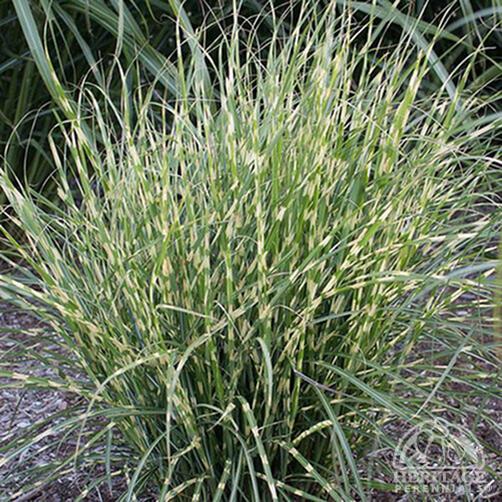Miscanthus sinensis Bandwidth
Plant number: 8.270.740(=‘NCMS2B’) Also known as Japanese Silver Grass, there are many selections now available, all providing a wonderful fall display of showy plumes that remain attractive all winter. This variety has broad, bright gold bands running along the length of rich, green leaf blades. Useful as a specimen, in the border, or for mass planting. Cut back to 4 inches in late winter or early spring. Clumps may be divided in spring before new growth appears. Miscanthus has escaped cultivation in some areas of North America, leading to concern about invasiveness. Although no jurisdictions have banned the landscape use of Miscanthus sinensis cultivars, they have been placed on ‘do not plant’ lists in some regions. We recommend gardeners should only plant cultivars (never the straight species) in managed gardens or landscapes where they can be watched and controlled for self seeding. Miscanthus is cross-pollinated, it requires two or more cultivars or species to set seed. USPP#29460: unlicensed propagation prohibited. Further details for |
| All 23 results here | Alphabetical list of all 4,000+ perennials here |
Miscanthus sinensis Bandwidth
Plant number: 8.270.740(=‘NCMS2B’) Also known as Japanese Silver Grass, there are many selections now available, all providing a wonderful fall display of showy plumes that remain attractive all winter. This variety has broad, bright gold bands running along the length of rich, green leaf blades. Useful as a specimen, in the border, or for mass planting. Cut back to 4 inches in late winter or early spring. Clumps may be divided in spring before new growth appears. Miscanthus has escaped cultivation in some areas of North America, leading to concern about invasiveness. Although no jurisdictions have banned the landscape use of Miscanthus sinensis cultivars, they have been placed on ‘do not plant’ lists in some regions. We recommend gardeners should only plant cultivars (never the straight species) in managed gardens or landscapes where they can be watched and controlled for self seeding. Miscanthus is cross-pollinated, it requires two or more cultivars or species to set seed. USPP#29460: unlicensed propagation prohibited. Further details for |






